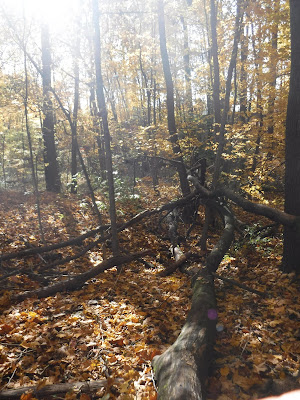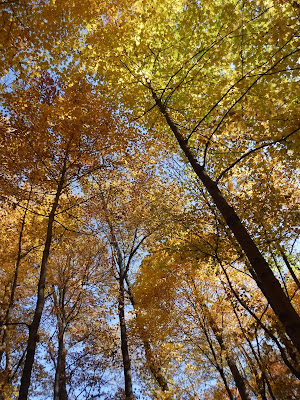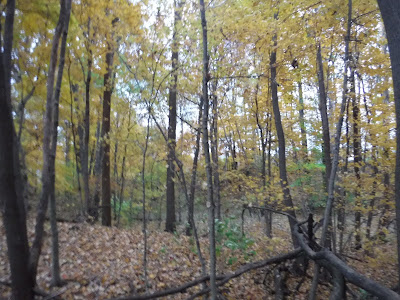15-Day Sit Spot
Challenge
Day #1: Wednesday,
November 7, and
Day #2: Thursday,
November 8, 2018
So begins a series of posts from one
spot.
First of all – what in the world is
this “Sit Spot Challenge”?
Well, the Wilderness Awareness School
does it every year, and this is the first year I've been able to
start from the beginning. People from all over the world participate!
All a participant does is choose a spot
to observe nature, and go to that spot every day for about 10 minutes
to an hour – or for whatever length of time one wants or is able to
spend there.
Each day, the administrator of the
Challenge presents a theme, question, or other type of prompt for the day.
Participants can then post comments and
photos on the event's Facebook page. It is so fascinating to follow
these posts from all over the country and the world, to see where the
spots are that people have chosen, why they have chosen these
particular spots, and what they have experienced. Some choose their
home place, or a park, or a deep natural area. Some find a spot in
the backyard, or patio, or even a scenic window. Some find a spot
near their workplace where they can spend part of a lunch hour. Some
people, by need, change their spots now and then. Some people include
children or grandchildren during their Sits, or pets.
Some write long, descriptive passages,
while others are sweetly succinct. There are haiku poems and other
poetic narratives, conversational pieces, the whole gamut. Someone in
Australia is talking about hearing kookaburras. Some places are
experiencing late autumn, posting photos of brilliant fall leaves,
while others are going into summer and posting photos of bright
purple flowers. On the same day, someone else shares snowy, icy
scenes. Someone shares a video of a rushing stream so we can hear it,
too. Others speak of the quiet. Some speak of challenges in their
lives that make it difficult to find a spot and some time, but that
they are grateful for the place and time, however small, that helps
them cope.
I am fortunate that, right at my home
place, I have so many places to choose to be. What I chose was a spot
on the far side of my woods (in relation to the house). I will
describe it in the Day #1 entry.
Every day, I will share the “challenge
of the day”, and maybe a quote, and then what I experienced at my
Sit Spot.
No one need wait for a designated
Challenge, of course. We can all do this anytime, for as many days as
we'd like, or even every day of our lives, when possible. But, it
helps to have a designated “challenge” to keep one going, and
there's the added joy of seeing what others are sharing about their
experiences.
And, now, I shall share with you.
Day #1
Wednesday, November 7,
2018
It is the day after the mid-term
elections, a time when everyone in the United States needs some quiet
contemplation, a place and time to focus on something different –
especially in this crazy year.
The prompt given for Day #1 is
to choose a Sit Spot, spend time there, and get to know that spot and
“who's there”.
I decided on a place on the farther
side of my narrow woods, a high and dry spot that affords me views of
a number of different situations and habitats. This has the potential
of presenting a wider variety of wildlife and experiences. Plant
density (and types of plants) varies. Topography varies. Openness
varies. Thus, there are distinct differences in wind, temperature,
the way precipitation falls, where micro-climates happen.
I chose a spot with an old fallen tree
(for simplicity's sake, I'll call it a “log” from now on).
Some old animal claw marks on the log
An "eye" in the log, accentuated by moss
In some directions I can see the upper
woodlands that tend to be composed of trees such as Black Walnut,
Tuliptree, Bitternut, Chinquapin Oak, Hackberry, Sugar Maple, White
Oak, Paw-paw, Red Oak, Black Cherry, Sassafras, American Hornbeam
(a.k.a.: Blue Beech, Musclewood).
Looking east to the ridgetop next to the crop field
Looking west
Paw-paw
In some directions I can see the
“bottoms” of my woods, the wide valley where the creek and its
tributaries wind through (sometimes heavily, sometimes
intermittently), where moisture spreads across the valley, supporting
thick populations of Jewelweed, Wood Nettle, False Nettle, Poison
Ivy, Smartweeds. The moisture and relatively sunnier conditions
support trees such as White Ash, Cottonwood, Boxelder, Sycamore (my
favorite), and some shrubbier species like Elderberry and Spicebush.
Down there, also, is a place where water gathers so heavily around a
downed Cottonwood tree that I dubbed it “Cottonwood Pond” and
started a blog for it several years ago.
Somewhere down below is Cottonwood Pond
Looking down into the bottoms, toward the south
Where the top of the fallen Cottonwood rests in the fork of a Red Oak tree, not far from my sit spot
Adjacent to the upper woods, not far
from my Sit Spot, there is a crop field. A soybean crop was recently
shaved off of it by huge, magnificent machinery, so the ground now
sits bald and brown, wide open to sun, rain and wind (until a cover
crop grows).
This juxtaposition provides one of the
most interesting habitats of all, seen from my Sit Spot: Edge
Habitat. Here is where birds and other animals can perch in relative
safety, and dart out over the open now and then for food or other
purposes. Here is where vines most commonly flourish (unfortunately,
many invasive vine species), providing ready fruit. Hackberry trees
love this, and sometimes also Red Cedars (which is actually a
Juniper, and the only evergreen indigenous to this part of Indiana).
Here is where sun and shade meet in an ambiguous dividing area, where
the shady woods invites one out of the heat and sun.
Just inside the woods, between my Sit
Spot and the Edge Habitat, a deer trail winds through. Deer cross the
road from our neighbors' place, skirt the woods along this edge, then
cut across the top of some wooded slopes until they reach the old
fence that they jump over to another crop field. No deer were spotted
during my first Sit Spot day, though I have watched them at other
times.
From here, too, I can see and hear some
human activity – hopefully not too much! I can see a couple of
neighbors' homes, and small sections of our country road through the
trees. I can hear some of the activity of neighbors, dogs barking
(including our own dogs), the occasional jet far above or smaller
plane whining much closer above, some traffic from the highway less
than a mile away. There is always the prospect of hearing farm
machinery.
*********************************************************************************
I started my visit around 12:30 pm
(Eastern Standard) while the day was cold, sunny and breezy. Autumn
colors were still at peak – not many leaves had been blown off the
trees by recent winds and rains, but the carpet of still-colorful
leaves was building up on the woodland floor. The sun illuminated the
density of golden Sugar Maple so brightly that it almost hurt to look
at them.
Two of my cats came with me. The big,
fluffy, marmalade-and-cream cat, Silas, sat on the log on my right.
The all-midnight-black cat, Pester, was against the left side of me.
Do they think they are protecting me? We all three sat quietly, and
observant.
I listened to the breeze stirring the
canopy well above me. In the light breeze, leaves drifted down
occasionally. I watched a deep russet Red Oak Leaf, with its pointed
lobes, dance down toward the floor and land with an abrupt click. A
golden, curved Sugar Maple leaf floated gently, slowly down like a
casual parachute, landing without a sound. Then, the breeze gusted to
a light wind, and leaves rained down from the trees, plummeting to
the floor.
I listened to the sounds of wildlife,
also: the loud, sharp cackle of Blue Jays; the staccato of a
woodpecker knocking on a tree; the humorous, repetitive call of a
White-Breasted Nuthatch, and some bird calls I did not know how to
identify. One was a curiously squeaky, high-pitched sound. When it
came into the trees closer to me, I realized that I needed to bring
along binoculars.
Did I hear a Chorus Frog in the
bottoms? Just a little bit? But, this time of year, and when it is
cold? Surely not, but I didn't know what else would sound like that.
A quiet rustle nearby – and a Fox
Squirrel popped up on the end of my log! At first it seemed aware of
us, watchful.
After awhile it became more casual,
nibbling on things, cleaning its fur.
So nonchalant
Pester, a friend of all species, had
become curious. He took a stalking kind of position and watched. When
the squirrel seemed unaware, Pester crept carefully along the log.
But, just before he got to the squirrel it leaped to a nearby tree,
leaving Pester puzzled. I watched the squirrel shimmy up the tree and
peek around at us.
Pester: "Wha ... where did it go?"
Squirrel: "Ha ha! See if you can find me now!"
A little more quiet time spent, and
then I thought I'd better be on my way. I started back on a different
route, along the high part (I had arrived via the bottom land and up
the slope), spotting some umbrella-like mushrooms along the way, and
an extra green sedge plant poking up through the earthy-colored leaf
litter.
I exited the woods and walked along the
road, then up the gravel driveway, back to a more domestic place,
gathering some green cherry tomatoes from the garden before going
into the house.
Note: Check out the Wilderness
Awareness School and all of its wonderful resources and classes by
going to: https://wildernessawareness.org
Also look for these Facebook groups:
Wilderness Awareness School, 15 Day Sit Spot Challenge Group.
Day #2
Thursday, November 8
Prompt: Find the four directions
from your spot. Which direction will you be facing, mostly? Where is
your Sit Spot?
This morning I did my regular yoga
session in the sunny kitchen. Before a morning yoga session, I
usually read that day's thoughts in the book A Year of Living Your
Yoga: Daily Practices to Shape Your Life; by
Judith Hanson Lasater. Here is today's:
“There is no place that is not your
yoga mat”
“Practicing yoga need not be confined
to your mat. Imagine today that the whole world is your yoga mat, and
everything that happens to you is an asana. Remember to breathe.”
Or, your Sit Spot.
I know the four directions from this
spot from watching the sun rise and set over the many years I have
lived here.
North:
To the right, "Krampus" is visible, an old root system of a fallen tree that, to me, resembles the large-horned, hairy monster from Alpine St. Nicholas Day tradition
Krampus, a bit closer
Krampus!!
East:
South:
West:
I tend to face north while sitting on the log, but I try to face other directions now and then, too.
Today was icy cold!! It was windy,
overcast, dry, somewhat dark. There was the feeling of winter coming
on. Silas was with me again, sitting up against me on the log. We
could hear a neighbor's dog barking. I was not able to get to the
spot until evening – between 5:00 and 6:00 pm Eastern, so dusk was
approaching quickly. I would not be able to stay long.
Silas
It was very quiet in the woods, but for
leaves fluttering in the wind. I noticed that the wind was pushing
the large Paw-paw leaves, which were still mostly clinging to their
twigs, into a horizontal position, as if they were sheets of thin
paper.
*********************************************************************************
Where IS my “sit spot”?
I'm not going to give fancy
coordinates. I will only say I am in southwestern Indiana, in the
southern portion of Knox County, in an area we refer to,
tongue-in-cheek, as “rural Verne”.
Here are some map details (I much prefer paper maps):
Indiana page of U.S. Rand
McNally road map – Knox County, halfway between Vincennes and
Monroe City.
DeLorme Atlas and Gazetteer, for
Indiana – between Hwy 61 (thick red) and Hart St. Rd.
Big paper fold-out map of Knox
County – between Lower Indiana Road and Hart St. Rd.
Soil Survey of Knox County,
Indiana (distributed in 1981 – five years before our house was
built)
The pale section of the AIB2 is the
crop field adjacent to our woodland. The darker part, between the
crop field and the AID3 border, is where my sit-spot is located. My
spot is located on Alford silt loam, 2-6% slopes, eroded. The section
is described as “ … broad, convex ridgetops, long side slopes,
and toe slopes of the uplands.” Though not very high elevation,
our land is all in the Knox County “highlands” - it doesn't flood
like so much of the county does.
From my spot, I can see down into
the AID3 area, which is also Alford silt loam, but with 12-18%
slopes, and “severely eroded”. This is what I call the “bottoms”
of my woodland, where the creek meanders through a valley that can be
rather soggy at times, and where water collects readily in some
spots. It is described as “below ridgetops and adjacent to
drainageways of the uplands”. Also mentioned is that it is well
suited to trees, so many of the areas are in woodland (much of the
AIB2 is in crop land).
It was getting darker, and my footing
would not be sure enough during that time of twilight, when
perception wavers between reality and non-reality. It was time to head
back down the slope, across the bottom, and up the far slope, back to
the house, toward the light, to warmth, and to where Richard was making a hot supper
for a cold night.













































Now this is a fascinating project. I enjoyed reading about your property. I have been all through this over the years but it was interesting to read about the land as described in the soil survey. It gave it a new way to look at it.
ReplyDeleteTerri is a true outdoors and naturalist. I guarantee it will be quite exciting interesting to follow her on her journey. I certainty will💚
ReplyDeleteThis is Peggy Criss. I meant to say outdoorswoman.
Delete